Unit 7 Seasons Grammar 课件(共30张PPT) 2023-2024学年牛津译林版英语八年级上册
文档属性
| 名称 | Unit 7 Seasons Grammar 课件(共30张PPT) 2023-2024学年牛津译林版英语八年级上册 | 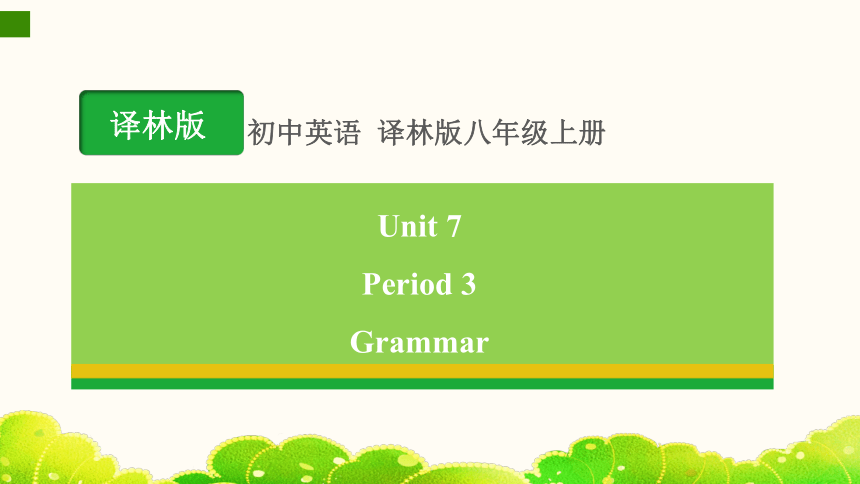 | |
| 格式 | pptx | ||
| 文件大小 | 2.4MB | ||
| 资源类型 | 教案 | ||
| 版本资源 | 牛津译林版 | ||
| 科目 | 英语 | ||
| 更新时间 | 2024-01-04 19:55:57 | ||
图片预览

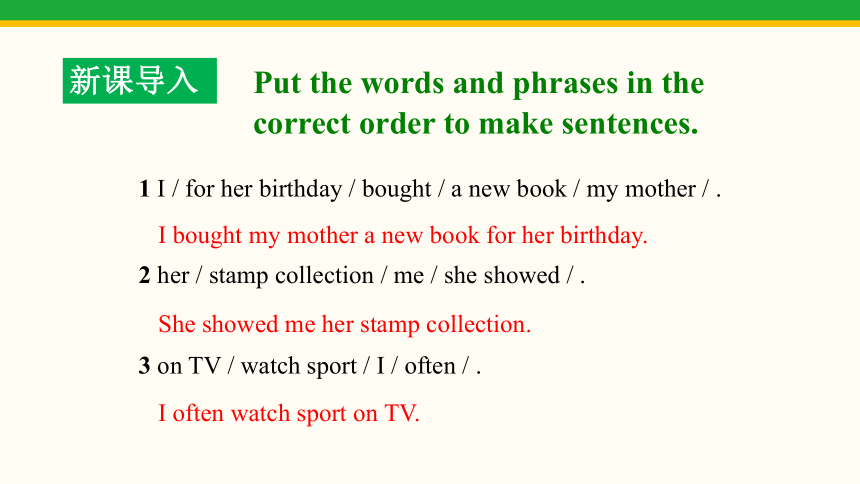
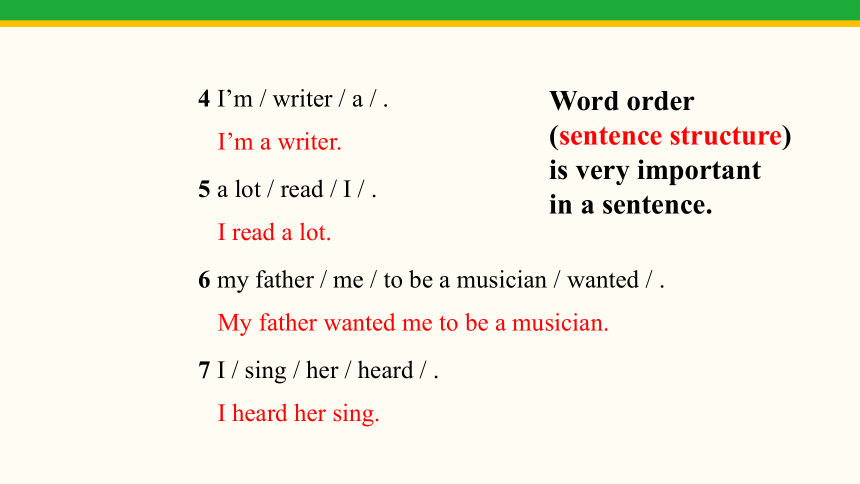
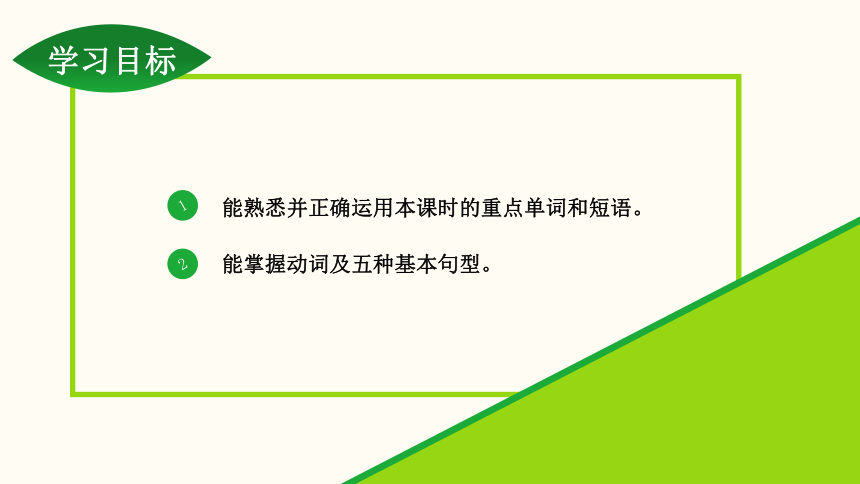
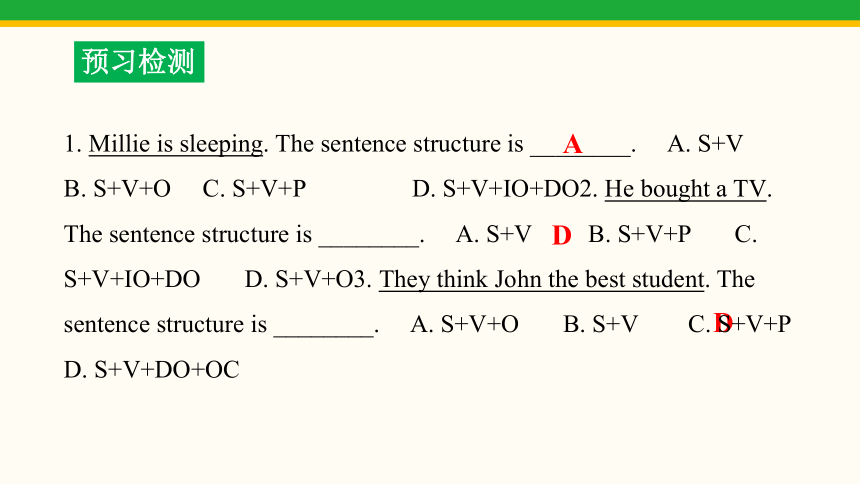
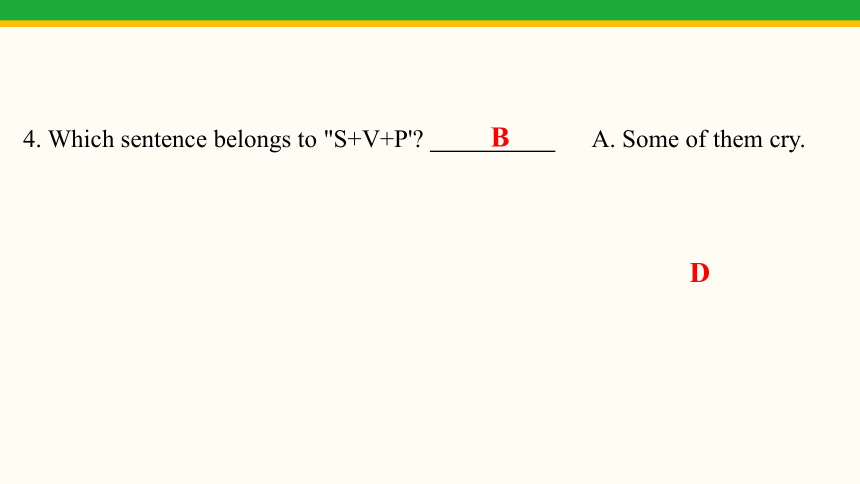
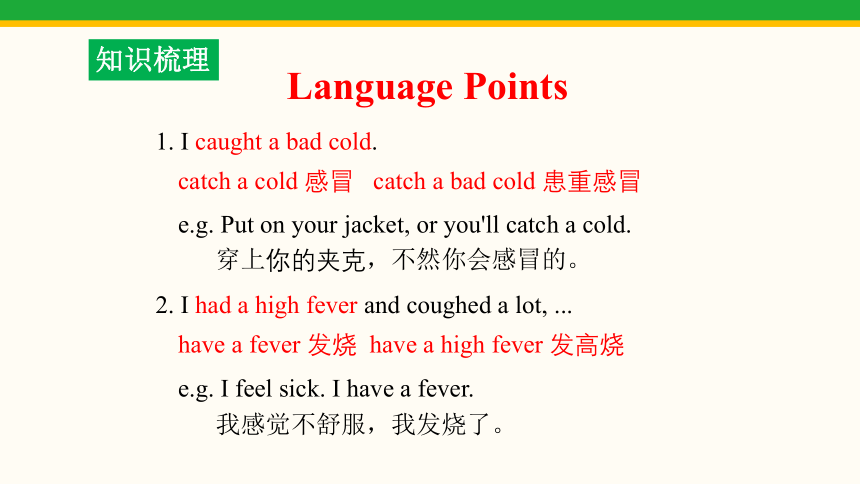
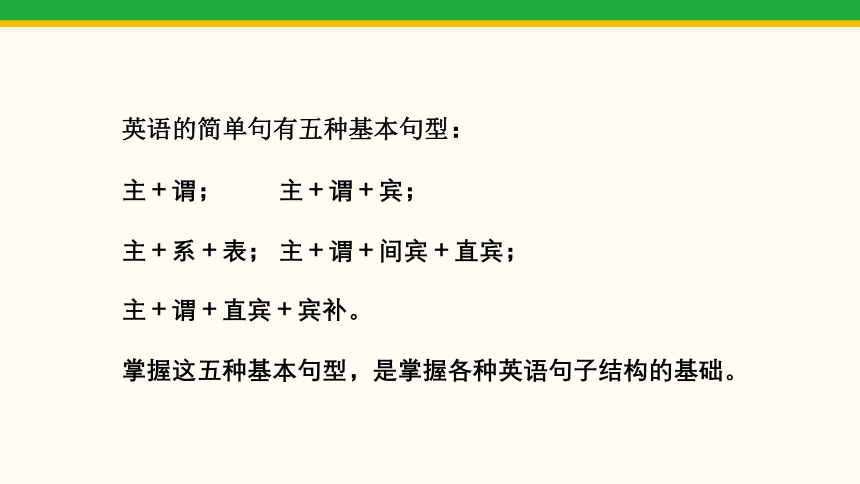
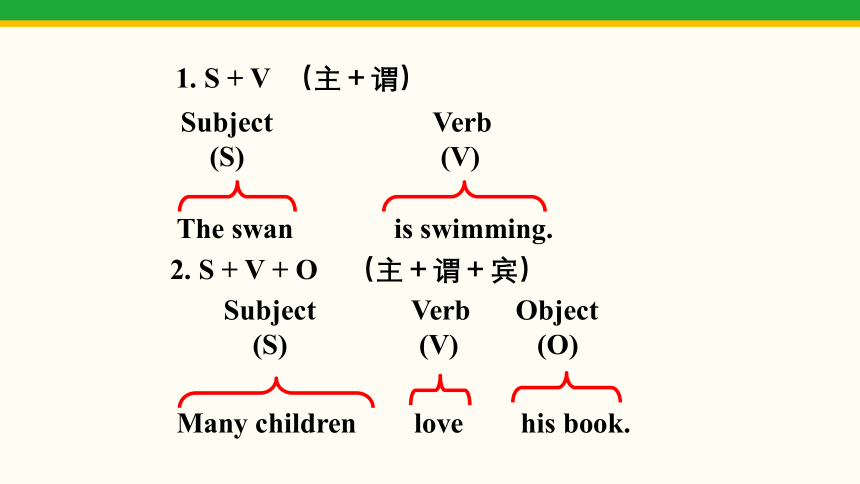
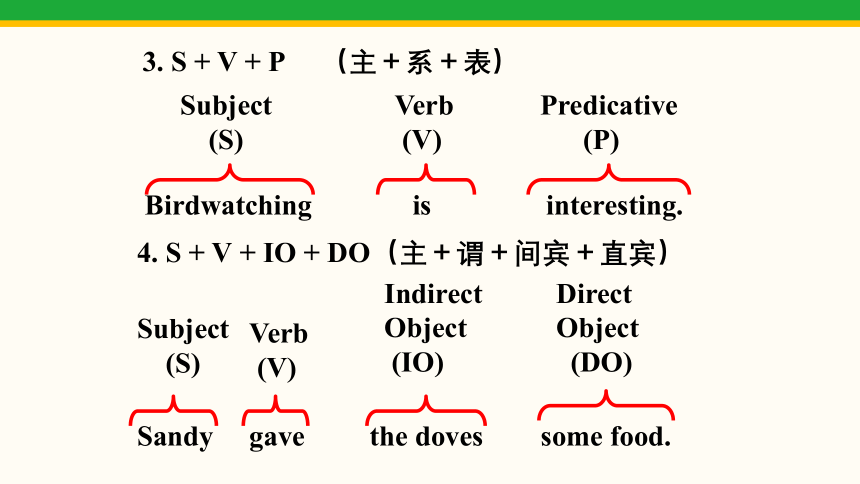

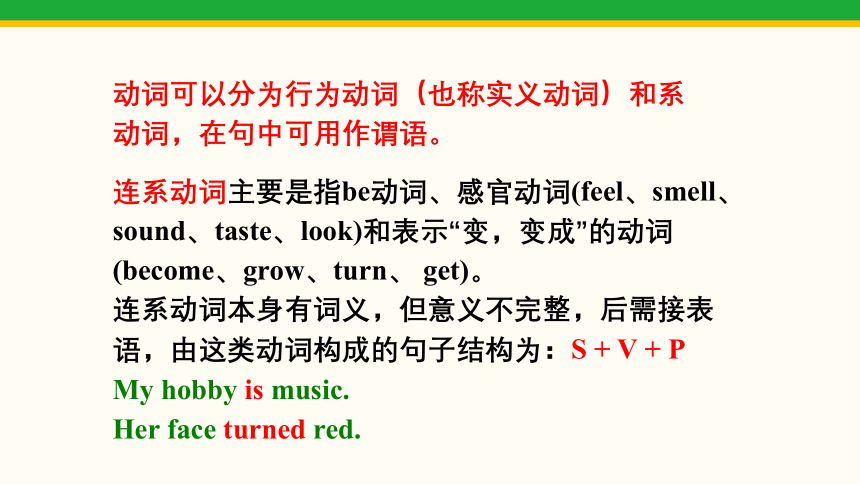
文档简介
(共30张PPT)
译林版
初中英语 译林版八年级上册
Unit 7
Period 3
Grammar
1 I / for her birthday / bought / a new book / my mother / .
新课导入
Put the words and phrases in the correct order to make sentences.
I bought my mother a new book for her birthday.
2 her / stamp collection / me / she showed / .
3 on TV / watch sport / I / often / .
She showed me her stamp collection.
I often watch sport on TV.
4 I’m / writer / a / .
5 a lot / read / I / .
6 my father / me / to be a musician / wanted / .
7 I / sing / her / heard / .
I’m a writer.
I read a lot.
My father wanted me to be a musician.
I heard her sing.
Word order (sentence structure)
is very important in a sentence.
1
2
能熟悉并正确运用本课时的重点单词和短语。
能掌握动词及五种基本句型。
预习检测
A
D
D
1. Millie is sleeping. The sentence structure is ________. A. S+V B. S+V+O C. S+V+P D. S+V+IO+DO2. He bought a TV. The sentence structure is ________. A. S+V B. S+V+P C. S+V+IO+DO D. S+V+O3. They think John the best student. The sentence structure is ________. A. S+V+O B. S+V C. S+V+P D. S+V+DO+OC
B
D
4. Which sentence belongs to "S+V+P' A. Some of them cry. B. They are very tired. C. Teenagers have many problems. D. They find their Maths teacher funny.5. We call the baby panda Xi Wang. The sentence structure is ________. A. S+V+DO B. S+V C. S+V+P D. S+V+DO+OC
知识梳理
1. I caught a bad cold.
catch a cold 感冒 catch a bad cold 患重感冒
e.g. Put on your jacket, or you'll catch a cold.
穿上你的夹克,不然你会感冒的。
Language Points
2. I had a high fever and coughed a lot, ...
have a fever 发烧 have a high fever 发高烧
e.g. I feel sick. I have a fever.
我感觉不舒服,我发烧了。
英语的简单句有五种基本句型:
主+谓; 主+谓+宾;
主+系+表; 主+谓+间宾+直宾;
主+谓+直宾+宾补。
掌握这五种基本句型,是掌握各种英语句子结构的基础。
Subject
(S)
Verb
(V)
Object
(O)
The swan is swimming.
Subject
(S)
Verb
(V)
2. S + V + O (主+谓+宾)
Many children love his book.
1. S + V (主+谓)
Subject
(S)
Verb
(V)
Direct
Object
(DO)
Birdwatching is interesting.
Subject
(S)
Verb
(V)
4. S + V + IO + DO(主+谓+间宾+直宾)
Sandy gave the doves some food.
3. S + V + P (主+系+表)
Predicative
(P)
Indirect Object
(IO)
Verb
(V)
Subject
(S)
Direct
Object
(DO)
5. S + V + DO + OC
(主+谓+直宾+宾补)
Sandy calls her parrot Chatty.
Object
Complement
(OC)
动词可以分为行为动词(也称实义动词)和系动词,在句中可用作谓语。
连系动词主要是指be动词、感官动词(feel、smell、sound、taste、look)和表示“变,变成”的动词(become、grow、turn、 get)。
连系动词本身有词义,但意义不完整,后需接表语,由这类动词构成的句子结构为:S + V + P
My hobby is music.
Her face turned red.
行为动词有实在的意义,可在句中独立作谓语,表示动作或状态。行为动词可分为及物动词和不及物动词。
不及物动词本身意义完整,无需带宾语。由这类动词构成的句子结构为:S + V
They all smiled.
及物动词本身意义不够完整,后面需接宾语。由这类动词构成的句子结构为:S + V + O;S + V + IO + DO;S + V + DO + OC
I have a car.
She showed me her new dress.
I saw him singing the song.
动词及五种基本句型
The basic parts of a sentence are the subject (S)主语
the verb (V)谓语动词
the object (O)宾语
Usually a statement begins with the subject and the verb.
We divide verbs into three kinds: intransitive verbs (vi.)不及物动词
transitive verbs (vt.)及物动词
linking verbs (linking v.)连系动词
An intransitive verb does not take a direct object.(不及物动词后不加宾语) The sentence structure is like this:
The temperature drops.
I don't know.
The little girl coughed.
The temperature drops.
I don't know.
The little girl coughed.
pronoun / noun phrase
intransitive verb (vi.)
subject (S)
verb (V)
S+V
Sentence structure:
A transitive verb takes an object. (及物动词后面加宾语,用以解释主语)
The verb tells us what the subject does to something else (the object).
The sentence structure is like this:
Farmers harvest crops.
I have a pen.
Her son has a fever.
Farmers harvest crops.
I have a pen.
Her son has a fever.
pronoun/ noun phrase
transitive verb (vt.)
pronoun/ noun phrase
subject (S)
verb (V)
object (O)
Sentence structure:
S+V+O
A linking verb links the subject and the adjective phrase or noun phrase that describes it.(连系动词连接主语与修饰它的形容词或名词词组)
A word or a group of words that follows a linking verb is the predicative (P)在系动词后面的词或词组叫做表语. The sentence structure is like this:
Autumn leaves turn brown.
Ice cream tastes nice.
A boy is kicking the ball.
Sentence structure:
S+V+P
Autumn leaves turn brown.
Ice cream tastes nice.
A boy is kicking the ball.
pronoun/ noun phrase
linking verb
word/ a group of words
subject (S)
verb (V)
predicative (P)
Millie is writing about the seasons. Help her underline the verb in each sentence and write down the main structure of the sentence.
1. We have four seasons.
2. They are quite different.
3. Spring is warm and sunny.
4. We fly kites.
___________________
___________________
___________________
___________________
S + V + O
S + V + P
S + V + P
S + V + O
___________________
___________________
___________________
___________________
5. We like summer.
6. Ice cream tastes nice.
7. Autumn arrives.
8. Snow falls.
S + V + O
S + V + P
S + V
S + V
Hobo brought clothes.
Hobo brought Eddie his clothes.
Hobo brought clothes.
Hobo brought Eddie his clothes.
pronoun/ noun phrase
transitive verb (vt.)
pronoun/ noun phrase
pronoun/ noun phrase
double objects
Some transitive verbs can take two objects, the direct object (DO)直接宾语
the indirect object (IO)间接宾语
S
V
IO
DO
Sentence structure:
S+V+IO+DO
We can change the structure
S +V +IO +DO with to.
Hobo gave Eddie some ice cream.
Hobo gave some ice cream to Eddie.
Hobo gave Eddie some ice cream.
S
V
IO
DO
Hobo
gave
some ice cream
to
Eddie
Verbs can be used with to:
bring give hand lend offer pass pay post read sell send show take teach tell write
We can change the structure
S +V +IO +DO with for.
Hobo built Eddie a tent.
Hobo built a tent for Eddie.
Hobo built Eddie a tent.
S
V
IO
DO
Hobo
built
a tent
for
Eddie
Verbs can be used with for:
bring build buy cook find get leave make order pick save
The complement can also follow a direct object to rename or describe it.
In this case, it is called the object complement (OC)宾语补足语(补语).
The sentence structure is like this:
Eddie is watching Hobo work.
We can add an adverbial to each of the above five main structures.
We use an adverbial to show when (adverbial of time), where (adverbial of place) or how (adverbial of manner) an action is done.
Eddie is watching Hobo work.
pronoun/ noun phrase
linking verb
pronoun/
noun phrase
complement (to describe Hobo)
S
V
DO
OC
Sentence structure:
S+V+DO+OC
Amy keeps a weather diary. Read the sentences from her diary entries and describe the main structures of each sentences.
1. It was a perfect day today. There was not a cloud in the sky. Mum was
making breakfast for me when I woke up this morning.
2. The cloud became dark. They covered the sun. Luckily, it didn't rain.
S+V+O
S+V+P
S+V
3. It was New Year's Day. Mum and Dad gave me nice presents, but I was
not happy. The rain was falling from morning till night. I hate rainy days.
4. The sun was shining. I saw some kids kicking the ball in the park. I caught
a bad cold. I had a high fever and coughed a lot, so Mum took me to the
hospital. It was an awful day!
S+V+IO+DO
S+V+P
S+V+O
S+V
S+V+DO+OC
通过以
活动小结
通过以上的活动,我们学习了动词及_____种基本句型:
1. 动词可分为___________(__________)和__________,前一类动词可以分为___________和____________。
2. 五种基本句型包括
1. _______________2._____________________
3. _______________________________
4. _______________________________
5. _______________________________
五
行为动词
实义动词
系动词
及物动词
不及物动词
主+谓 (S+V)
主+谓+宾 (S+V+O)
主+系+表 (S+V+P)
主+谓+间宾+直宾 (S+V+IO+DO)
主+谓+直宾+宾补 (S+V+DO+OC)
当堂检测
_________________
_________________
_________________
_________________
_________________
_________________
写出下列句子的主要结构。
(S + V)
(S + V + P)
(S + V + P)
(S + V + O)
(S + V + IO + DO)
(S + V + DO + OC)
1. Millie is sleeping.
2. Ann is kind.
3. The idea sounds great.
4. Amy is reading English.
5. Mary gave Sandy a book.
6. They call me Tom.
重点单词和短语:
cloud, kick, fever, cough, awful, have a cold, have a fever
动词及五种基本句型:
1. 动词可分为___________(__________)和__________,前一类动词可以分为___________和____________。
2. 五种基本句型包括
a. _______________________________
b. _______________________________
c. _______________________________
d._______________________________
e._______________________________
Unit 7
Period 3
行为动词
实义动词
系动词
及物动词
不及物动词
主+谓 (S+V)
主+谓+宾 (S+V+O)
主+系+表 (S+V+P)
主+谓+间宾+直宾 (S+V+IO+DO)
主+谓+直宾+宾补 (S+V+DO+OC)
译林版
初中英语 译林版八年级上册
Unit 7
Period 3
Grammar
1 I / for her birthday / bought / a new book / my mother / .
新课导入
Put the words and phrases in the correct order to make sentences.
I bought my mother a new book for her birthday.
2 her / stamp collection / me / she showed / .
3 on TV / watch sport / I / often / .
She showed me her stamp collection.
I often watch sport on TV.
4 I’m / writer / a / .
5 a lot / read / I / .
6 my father / me / to be a musician / wanted / .
7 I / sing / her / heard / .
I’m a writer.
I read a lot.
My father wanted me to be a musician.
I heard her sing.
Word order (sentence structure)
is very important in a sentence.
1
2
能熟悉并正确运用本课时的重点单词和短语。
能掌握动词及五种基本句型。
预习检测
A
D
D
1. Millie is sleeping. The sentence structure is ________. A. S+V B. S+V+O C. S+V+P D. S+V+IO+DO2. He bought a TV. The sentence structure is ________. A. S+V B. S+V+P C. S+V+IO+DO D. S+V+O3. They think John the best student. The sentence structure is ________. A. S+V+O B. S+V C. S+V+P D. S+V+DO+OC
B
D
4. Which sentence belongs to "S+V+P' A. Some of them cry. B. They are very tired. C. Teenagers have many problems. D. They find their Maths teacher funny.5. We call the baby panda Xi Wang. The sentence structure is ________. A. S+V+DO B. S+V C. S+V+P D. S+V+DO+OC
知识梳理
1. I caught a bad cold.
catch a cold 感冒 catch a bad cold 患重感冒
e.g. Put on your jacket, or you'll catch a cold.
穿上你的夹克,不然你会感冒的。
Language Points
2. I had a high fever and coughed a lot, ...
have a fever 发烧 have a high fever 发高烧
e.g. I feel sick. I have a fever.
我感觉不舒服,我发烧了。
英语的简单句有五种基本句型:
主+谓; 主+谓+宾;
主+系+表; 主+谓+间宾+直宾;
主+谓+直宾+宾补。
掌握这五种基本句型,是掌握各种英语句子结构的基础。
Subject
(S)
Verb
(V)
Object
(O)
The swan is swimming.
Subject
(S)
Verb
(V)
2. S + V + O (主+谓+宾)
Many children love his book.
1. S + V (主+谓)
Subject
(S)
Verb
(V)
Direct
Object
(DO)
Birdwatching is interesting.
Subject
(S)
Verb
(V)
4. S + V + IO + DO(主+谓+间宾+直宾)
Sandy gave the doves some food.
3. S + V + P (主+系+表)
Predicative
(P)
Indirect Object
(IO)
Verb
(V)
Subject
(S)
Direct
Object
(DO)
5. S + V + DO + OC
(主+谓+直宾+宾补)
Sandy calls her parrot Chatty.
Object
Complement
(OC)
动词可以分为行为动词(也称实义动词)和系动词,在句中可用作谓语。
连系动词主要是指be动词、感官动词(feel、smell、sound、taste、look)和表示“变,变成”的动词(become、grow、turn、 get)。
连系动词本身有词义,但意义不完整,后需接表语,由这类动词构成的句子结构为:S + V + P
My hobby is music.
Her face turned red.
行为动词有实在的意义,可在句中独立作谓语,表示动作或状态。行为动词可分为及物动词和不及物动词。
不及物动词本身意义完整,无需带宾语。由这类动词构成的句子结构为:S + V
They all smiled.
及物动词本身意义不够完整,后面需接宾语。由这类动词构成的句子结构为:S + V + O;S + V + IO + DO;S + V + DO + OC
I have a car.
She showed me her new dress.
I saw him singing the song.
动词及五种基本句型
The basic parts of a sentence are the subject (S)主语
the verb (V)谓语动词
the object (O)宾语
Usually a statement begins with the subject and the verb.
We divide verbs into three kinds: intransitive verbs (vi.)不及物动词
transitive verbs (vt.)及物动词
linking verbs (linking v.)连系动词
An intransitive verb does not take a direct object.(不及物动词后不加宾语) The sentence structure is like this:
The temperature drops.
I don't know.
The little girl coughed.
The temperature drops.
I don't know.
The little girl coughed.
pronoun / noun phrase
intransitive verb (vi.)
subject (S)
verb (V)
S+V
Sentence structure:
A transitive verb takes an object. (及物动词后面加宾语,用以解释主语)
The verb tells us what the subject does to something else (the object).
The sentence structure is like this:
Farmers harvest crops.
I have a pen.
Her son has a fever.
Farmers harvest crops.
I have a pen.
Her son has a fever.
pronoun/ noun phrase
transitive verb (vt.)
pronoun/ noun phrase
subject (S)
verb (V)
object (O)
Sentence structure:
S+V+O
A linking verb links the subject and the adjective phrase or noun phrase that describes it.(连系动词连接主语与修饰它的形容词或名词词组)
A word or a group of words that follows a linking verb is the predicative (P)在系动词后面的词或词组叫做表语. The sentence structure is like this:
Autumn leaves turn brown.
Ice cream tastes nice.
A boy is kicking the ball.
Sentence structure:
S+V+P
Autumn leaves turn brown.
Ice cream tastes nice.
A boy is kicking the ball.
pronoun/ noun phrase
linking verb
word/ a group of words
subject (S)
verb (V)
predicative (P)
Millie is writing about the seasons. Help her underline the verb in each sentence and write down the main structure of the sentence.
1. We have four seasons.
2. They are quite different.
3. Spring is warm and sunny.
4. We fly kites.
___________________
___________________
___________________
___________________
S + V + O
S + V + P
S + V + P
S + V + O
___________________
___________________
___________________
___________________
5. We like summer.
6. Ice cream tastes nice.
7. Autumn arrives.
8. Snow falls.
S + V + O
S + V + P
S + V
S + V
Hobo brought clothes.
Hobo brought Eddie his clothes.
Hobo brought clothes.
Hobo brought Eddie his clothes.
pronoun/ noun phrase
transitive verb (vt.)
pronoun/ noun phrase
pronoun/ noun phrase
double objects
Some transitive verbs can take two objects, the direct object (DO)直接宾语
the indirect object (IO)间接宾语
S
V
IO
DO
Sentence structure:
S+V+IO+DO
We can change the structure
S +V +IO +DO with to.
Hobo gave Eddie some ice cream.
Hobo gave some ice cream to Eddie.
Hobo gave Eddie some ice cream.
S
V
IO
DO
Hobo
gave
some ice cream
to
Eddie
Verbs can be used with to:
bring give hand lend offer pass pay post read sell send show take teach tell write
We can change the structure
S +V +IO +DO with for.
Hobo built Eddie a tent.
Hobo built a tent for Eddie.
Hobo built Eddie a tent.
S
V
IO
DO
Hobo
built
a tent
for
Eddie
Verbs can be used with for:
bring build buy cook find get leave make order pick save
The complement can also follow a direct object to rename or describe it.
In this case, it is called the object complement (OC)宾语补足语(补语).
The sentence structure is like this:
Eddie is watching Hobo work.
We can add an adverbial to each of the above five main structures.
We use an adverbial to show when (adverbial of time), where (adverbial of place) or how (adverbial of manner) an action is done.
Eddie is watching Hobo work.
pronoun/ noun phrase
linking verb
pronoun/
noun phrase
complement (to describe Hobo)
S
V
DO
OC
Sentence structure:
S+V+DO+OC
Amy keeps a weather diary. Read the sentences from her diary entries and describe the main structures of each sentences.
1. It was a perfect day today. There was not a cloud in the sky. Mum was
making breakfast for me when I woke up this morning.
2. The cloud became dark. They covered the sun. Luckily, it didn't rain.
S+V+O
S+V+P
S+V
3. It was New Year's Day. Mum and Dad gave me nice presents, but I was
not happy. The rain was falling from morning till night. I hate rainy days.
4. The sun was shining. I saw some kids kicking the ball in the park. I caught
a bad cold. I had a high fever and coughed a lot, so Mum took me to the
hospital. It was an awful day!
S+V+IO+DO
S+V+P
S+V+O
S+V
S+V+DO+OC
通过以
活动小结
通过以上的活动,我们学习了动词及_____种基本句型:
1. 动词可分为___________(__________)和__________,前一类动词可以分为___________和____________。
2. 五种基本句型包括
1. _______________2._____________________
3. _______________________________
4. _______________________________
5. _______________________________
五
行为动词
实义动词
系动词
及物动词
不及物动词
主+谓 (S+V)
主+谓+宾 (S+V+O)
主+系+表 (S+V+P)
主+谓+间宾+直宾 (S+V+IO+DO)
主+谓+直宾+宾补 (S+V+DO+OC)
当堂检测
_________________
_________________
_________________
_________________
_________________
_________________
写出下列句子的主要结构。
(S + V)
(S + V + P)
(S + V + P)
(S + V + O)
(S + V + IO + DO)
(S + V + DO + OC)
1. Millie is sleeping.
2. Ann is kind.
3. The idea sounds great.
4. Amy is reading English.
5. Mary gave Sandy a book.
6. They call me Tom.
重点单词和短语:
cloud, kick, fever, cough, awful, have a cold, have a fever
动词及五种基本句型:
1. 动词可分为___________(__________)和__________,前一类动词可以分为___________和____________。
2. 五种基本句型包括
a. _______________________________
b. _______________________________
c. _______________________________
d._______________________________
e._______________________________
Unit 7
Period 3
行为动词
实义动词
系动词
及物动词
不及物动词
主+谓 (S+V)
主+谓+宾 (S+V+O)
主+系+表 (S+V+P)
主+谓+间宾+直宾 (S+V+IO+DO)
主+谓+直宾+宾补 (S+V+DO+OC)
